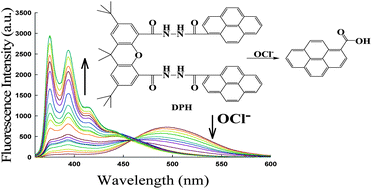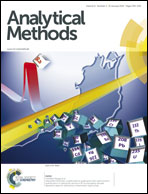An efficient ratiometric fluorescent excimer probe for hypochlorite based on a cofacial xanthene-bridged bispyrene†
Abstract
In this paper, by employing a rigid xanthene scaffold as a bridge, we for the first time report a cofacial bispyrene derivative DPH as an efficient ratiometric fluorescent excimer probe for hypochlorite (OCl−). The probe is comprised of a rigid xanthene scaffold and two parallel pyrenes, which are linked by an OCl−-sensitive dicarboxylic acid hydrazide group. The introduction of OCl−, however, will induce oxidation of the dicarboxylic acid hydrazide moiety into a diimide group, and the subsequent hydrolysis of the diimide, to give 1-pyrenecarboxylic acid which exhibits a monomer emission at about 380 nm, with its intensity increasing with the addition of increased concentration of OCl−. Meanwhile, the excimer emission intensity gradually decreases. Such a ratiometric fluorescent response of the probe affords a high sensitivity to OCl−, with a linear response concentration range of 1 to 300 μM, and a detection limit of 0.35 μM for OCl−. It also shows a high selectivity for OCl− with no interference observed from other common anions and small molecules. Moreover, it can also act as a colorimetric probe for OCl− due to the cyan-to-blue fluorescence color change. It has been preliminarily used for practical detection of OCl− in river water samples with satisfying results.


 Please wait while we load your content...
Please wait while we load your content...